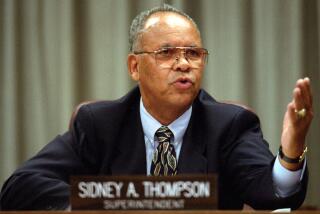Terry Sanford; Former N.C. Senator, Governor Upgraded State’s Schools
- Share via
RALEIGH, N.C. — Terry Sanford, a North Carolina governor and U.S. senator who twice ran for the Democratic presidential nomination, died Saturday of complications from cancer. He was 80.
Sanford died at his Durham home surrounded by his wife and children, family friend Tom Drew said.
President of Duke University for 16 years, Sanford made lasting improvements in the state’s education system during his tenure as governor, said Gov. Jim Hunt, a fellow Democrat, on Saturday.
“Terry’s spirit of boundless optimism and commitment to excellence for our children and our public schools have changed us forever,” he said.
Sanford, governor from 1961 to 1965, was listed in a 1981 Harvard University study as one of the nation’s 10 best governors this century. He was president of Duke from 1969 to 1985, during which he made unsuccessful presidential bids in 1972 and 1976.
He was elected to the Senate in 1986, losing his bid for a second term six years later shortly after undergoing heart surgery. His most controversial stand during his term was his opposition to the Persian Gulf War.
In his 1972 presidential campaign, Sanford pressed for more government action to promote jobs and a balanced budget. He opposed a national gun control law.
In 1976, the Democratic nomination for president went to another Southerner, former Georgia Gov. Jimmy Carter.
While running for governor in 1960, Sanford became an early supporter of John F. Kennedy’s presidential bid, breaking with the rest of the North Carolina convention delegation. Sanford campaigned hard on the theme of education reform, arguing that a well-trained work force would be essential to luring high-tech jobs.
The 1960 election marked a turning point in a state that had previously elected Democrats by landslides, said Thad Beyle, a political scientist at the University of North Carolina, Chapel Hill. Sanford won, but far more narrowly, “because of where he stood on a lot of issues,” Beyle said.
“He was seen as somebody who was trying to help the blacks out,” Beyle said. “And, in fact, a lot of what he did eased the path of desegregation.”
Sanford later concentrated his efforts on getting a world-class performing arts center built between Raleigh and Durham. Fund-raising for the center is still going on.
Survivors include Sanford’s wife of 52 years, Margaret; his son, Terry Sanford Jr.; his daughter, Betsee; two grandchildren; and two sisters.
More to Read
Sign up for Essential California
The most important California stories and recommendations in your inbox every morning.
You may occasionally receive promotional content from the Los Angeles Times.













